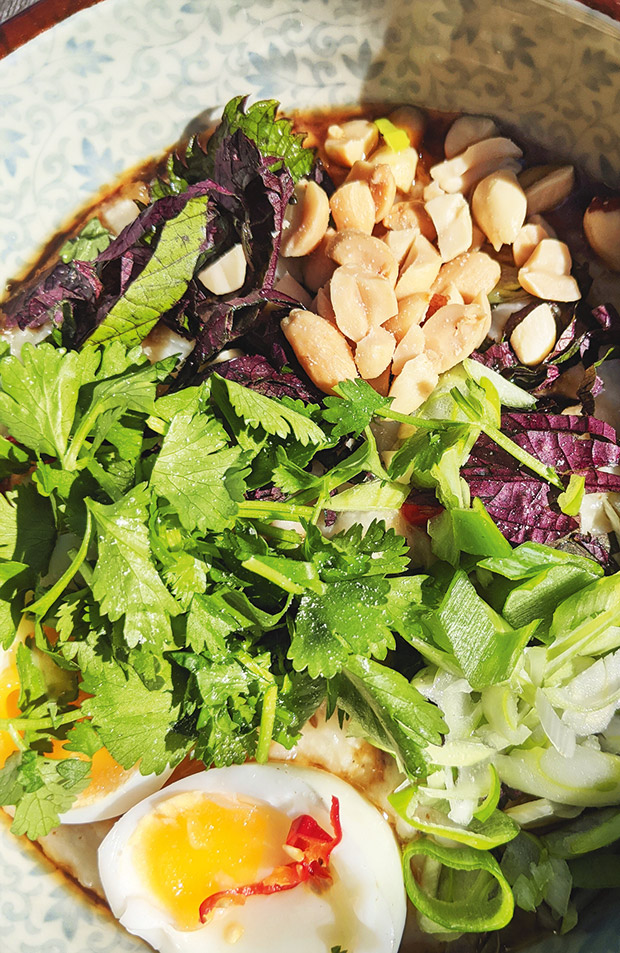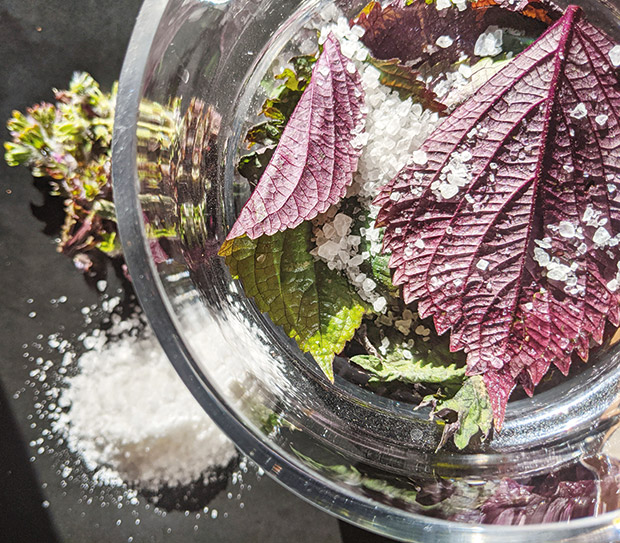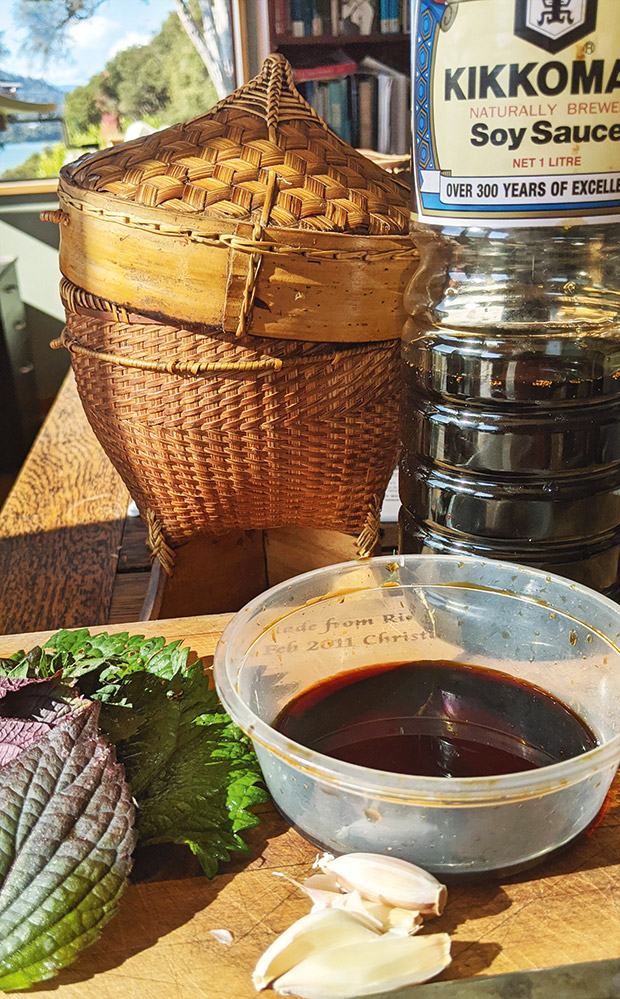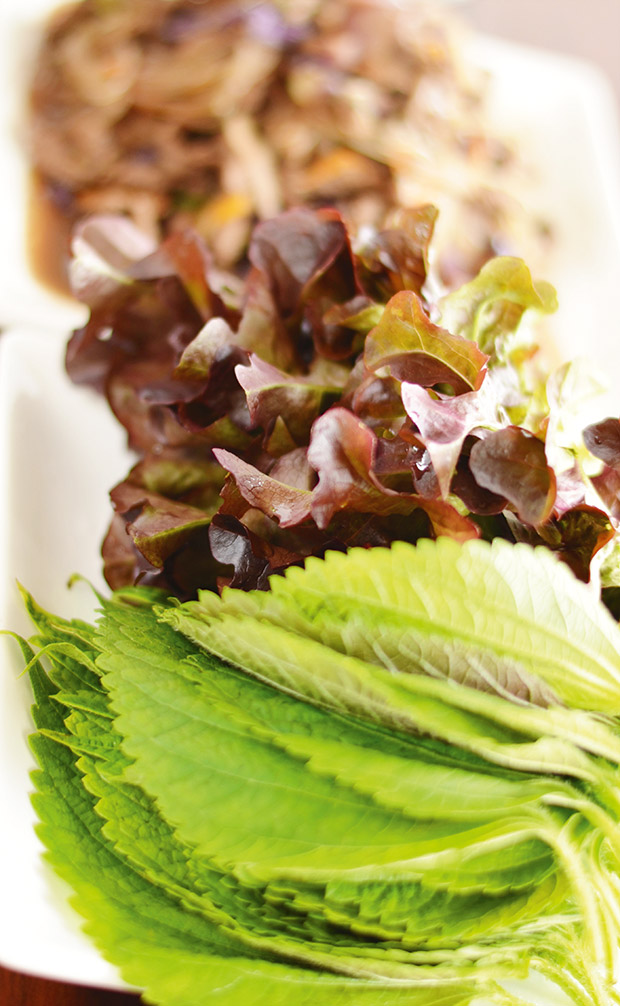5 tasty ways to cook with shiso

This herb is both easy to grow and a delicious addition to your cooking roster.
Words & images: Jenny Garing
Shiso Rice Bowl
This recipe uses fresh shiso leaves to make a quick, easy lunch or dinner. You can either use freshly cooked rice (done however you like to cook rice) or use sushi rice (with rice vinegar and sugar mixed in) and make it a trendy poke bowl.
You could add canned tuna or salmon for extra protein or fresh radishes or diced cucumber for extra crunch.
INGREDIENTS
2 cups cooked rice
2 tsp soya sauce
2 tsp sesame oil
1 tbsp salted peanuts
1 spring onion, finely sliced
small handful coriander leaves
3 large shiso leaves, sliced
1 soft boiled egg, carefully cut in half
1 small red chilli, finely sliced
METHOD
Spoon the hot rice into a bowl. Drizzle with soya sauce and sesame oil.
Top with the rest of the ingredients, divided into sections over the top of the rice.
Salted Shiso Leaves

Salting is the traditional way to preserve red or green shiso leaves. Only preserve large, unblemished leaves.
The salted leaves can be quickly rinsed or used as-is. Salted shiso leaves are great onigiri (rice ball) wrappers instead of nori – don’t salt your hands when forming the sushi rice balls. Wrap the leaves around ground pork, chicken, beef, or veggie patties and pan-fry them for a crispy, fragrant surface.
The leaves can also be shredded and tossed with hot pasta. Since the leaves are salty, adjust the amount of salt overall in the dish.
INGREDIENTS
shiso leaves
plain salt
METHOD
Wash and dry the leaves carefully.
Pack down in layers in a non-reactive container (glass, ceramic, plastic or enamel – not metal) and sprinkle salt between each leaf.
Cover and leave in the fridge for at least a few days. The leaves will exude moisture and turn dark green (or darker red if you’re using the red leaves).
Shiso Leaves in Garlic Soy Sauce

Another way to preserve shiso is to marinate leaves in soy sauce with garlic cloves.
That way, you get two end-products: the shiso leaves and the infused soy sauce. If you blanch the leaves in boiling water beforehand, they last longer, but it’s not essential.
INGREDIENTS
10 shiso leaves
3 cloves garlic, thinly sliced
½ cup soy sauce
METHOD
Slice the garlic and place in a small container or jar with the shiso – it should be small enough that when you add the soy sauce, it covers the garlic.
Add the soy sauce and leave to infuse for at least a day. Store in the fridge. The leaves last about a month. The soy sauce becomes pleasantly flavoured with the shiso and garlic. Both can be used when cooking meat, added to vegetable dishes, and salad dressings.
Gaennip Kimchi (korean-style fermented shiso leaves)

Here’s a delicious, traditional Korean way to use shiso.
INGREDIENTS
1 large bunch shiso leaves (enough to loosely stack 5-7cm high)
sea salt
2 tsp mam ruoc/Vietnamese or other Asian
fermented shrimp paste or Malaysian blachan
2 tsp nuoc mam/Vietnamese or other Asian fish sauce
2 tsp gochujang Korean chilli paste, or more if you like it spicy
2-3 cloves garlic minced
1 knob fresh ginger peeled and minced
boiled, cooled water
METHOD
Wash the shiso leaves and remove the stems. Stack the leaves with a fine layer of sea salt in between every second leaf. Put the leaves into a glass or ceramic bowl with just enough water to cover. Leave for several hours or overnight, then drain.
In a separate bowl, mix the rest of the ingredients until you get a loose paste.
Use a butter knife or the back of a spoon to spread a little bit of the paste in between every second leaf, until all the chilli paste is used up.
Fold up the whole stack and place into a clean, sterile jar or fermenting crock. Add boiled, cooled water until the leaves are covered, then close the jar loosely, or use an airlock fermentation lid.
Leave in a cool, dark place to ferment. It takes about a week, although in cool weather it could take longer. Unless you are using an airlock fermenting lid, you should check the lid every day to see if any fermentation gas needs to escape.
Serving options:
■ a small plate of the leaves can be served as a banchan (side dish);
■ mince the leaves into vegetables or salads for a spicy kick;
■ wrap shiso and bulgogi (Korean barbecued meat) in a lettuce leaf.
Shiso, Grapefruit & Avocado Salad
Serves: 4
Time: 10 minutes
INGREDIENTS
¼ cup seasoned rice wine vinegar
3 tbsp fresh, chopped shiso,
plus 5 whole leaves
2 tbsp extra-virgin olive oil
1 small-medium fennel bulb, quartered and cored
2 Ruby grapefruit
2 firm-ripe avocados, cut into pieces pepper and coarse sea salt
METHOD
Whisk together the vinegar, chopped shiso, and oil in a medium bowl.
Use a knife or mandolin to slice the fennel very thinly.
Slice the top off each grapefruit. Sit on the cut end and use a small, sharp knife to cut off the peel from top to bottom, following the curve of the fruit. Hold the fruit over a bowl and slice between membranes to release the segments into the bowl.
Add the fennel and avocado to the bowl, and top with a few grinds of pepper. Gently toss to coat, then season to taste with salt. Transfer to a shallow bowl, add dressing, and toss.
Cut the whole shiso leaves into thin strips and sprinkle onto the salad.
MORE HERE
Love this story? Subscribe now!
 This article first appeared in NZ Lifestyle Block Magazine.
This article first appeared in NZ Lifestyle Block Magazine.

